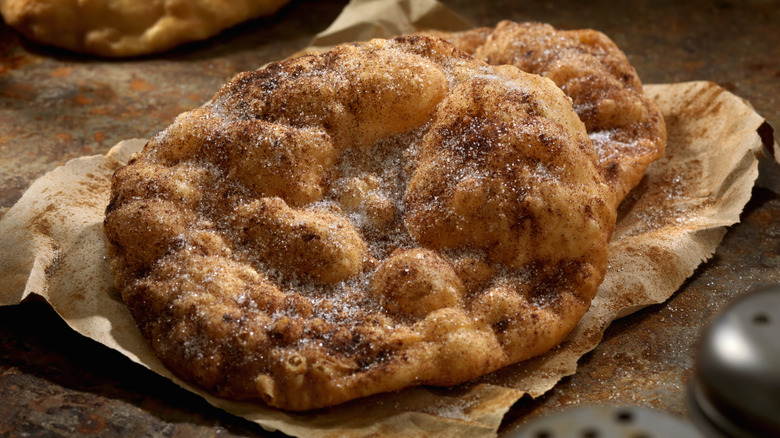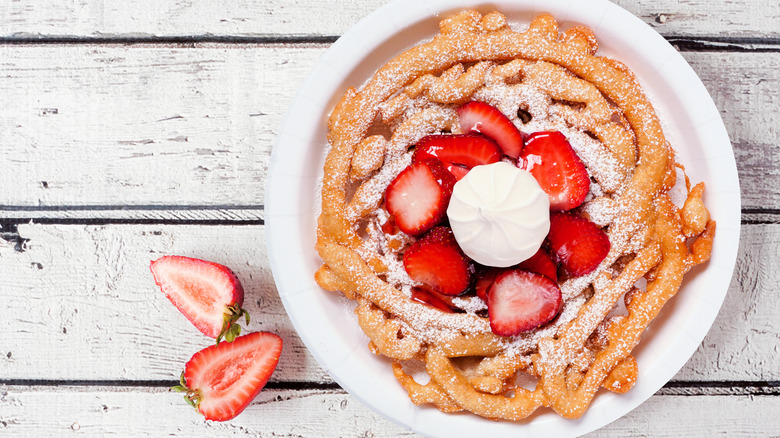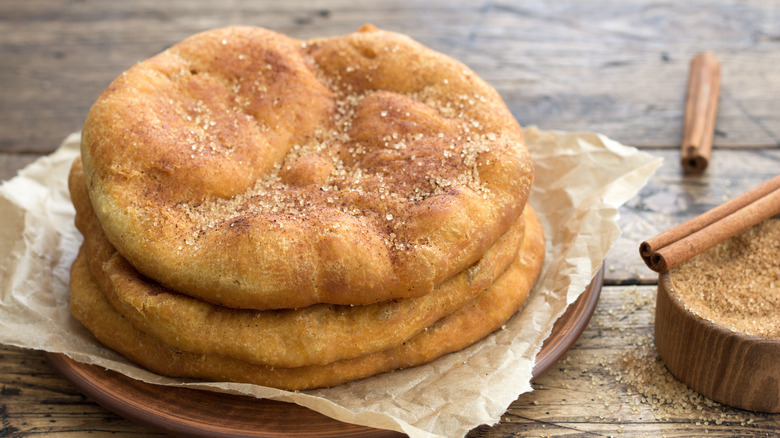The Difference Between Funnel Cakes And Elephant Ears
What's a visit to the county fair without a delectable, crispy funnel cake or elephant ear covered in sugar? These two sweet treats are a staple at carnivals and related venues. They share some of the same ingredients and toppings, too. Plus, they're both fried in oil and not exactly the healthiest, but who cares about those things when you're at the carnival, right? That's where you're supposed to eat junk food. These two foods also both feature a large circular shape that can fit perfectly on a big plate, but they differ in a few ways, as well.
The most obvious difference between these two fritters can be detected simply by looking at each of them. Although they both have a similar disc-like appearance, funnel cakes have discernable, lacy sections in them, comparable to a pretzel, but with a lot more overlapping pieces. Elephant ears typically have large bubbles caused by air pockets, but the mass is just one big blob.
This contrasting appearance points to a few other key differences between elephant ears and funnel cakes: their ingredients, how they're made, and the tools needed to make them. (Hint hint, they're called funnel cakes for a reason.)
Funnel cake batter is comparable to pancake batter
You can find dozens of funnel cake recipes online, including an easy four-ingredient funnel cake recipe. Regardless of which recipe is used, funnel cakes are typically made with flour, sugar, baking powder, salt, and milk or water.
Now for the "funnel" part. Making a funnel cake requires, well, a funnel (hence the name) or a piping bag. The diameter of the opening determines the thickness of the snake-like, layered pieces, so make sure it's large enough for the batter to easily ooze through. From start to finish, you can make a funnel cake in less than 15 minutes (including prep time).
After the funnel cakes have been removed from the oil, they're topped with powdered sugar, but of course, the toppings don't end there. Many venues offer other ingredients like fruit, whipped cream, and chocolate as well. You've probably seen or had a funnel cake topped with ice cream, too. Indeed, there are many options when it comes to toppings, especially if you're making them yourself at home.
Elephant ears are made with yeast dough
Unlike funnel cakes, elephant ears use a specific ingredient to aid in the rising process and add flavor: yeast. Although you usually don't have to wait long for an elephant ear at the fair, the entire preparation time actually takes over an hour because of that yeast, as any at-home elephant ear recipe tends to reveal.
The toppings are another difference between these two fritters. Standard funnel cake recipes don't call for cinnamon, but for elephant ears, the cinnamon-sugar combo is basically a must, as Beth Tapp, co-owner of Tapp Concessions, explained to The Chicago Tribune. Speaking of sugar, elephant ears are usually sprinkled with regular granulated sugar, not the powdered variety, like in the case of funnel cakes.
Tapp also summarized the primary difference between funnel cakes and elephant ears, saying, "An elephant ear is sweet pastry dough, and a funnel cake is a batter, like a pancake or waffle cake batter." She continued, "So, totally different but similar, like people." They're also both pretty hard to turn down while passing a funnel cake or elephant ear vendor at the fair if you have a sweet tooth and enjoy fried foods.


